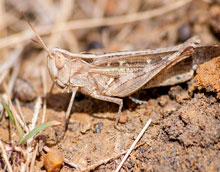Beginning with the locust swarms described in the Bible, accounting for one of the deadlier plagues to strike ancient Egypt, insect swarms have been an intriguing and particularly lethal aspect of Mother Nature. Witnessing swarms of insects on a large scale from the inside out can be a truly frightening experience that elicits apocalyptic thoughts. However, the occurrence is one that is completely natural. The act of swarming by insects is caused through the release of chemical signals given off by male insects in an effort to find females with which to mate. When one insects releases chemical pheromones, another is drawn to the area who, in turn, releases his chemicals, making the numbers increase, causing the swarm.
Society on a Miniature Level
It’s not only insects that have a tendency to swarm. This same behavior is seen in fish and mammals as well. Additionally, swarming is not limited to frightening insects such as the locust. Butterflies, mosquitoes, and other non-threatening creatures will congregate in this manner. The likelihood of an insect swarm can also depend on many environmental factors, including the temperature in the air, the relative air pressure, and migration patterns that occur during certain times of the year. For example, the monarch butterflies of North America gather in enormous numbers as they set up new colonies during the transition in seasons. For creatures such as these, the practice of swarming is a purely social behavior rather than being one that is necessarily destructive. Most people have seen a person covered in bees or wearing the infamous beard of bees. People cause the bees to swarm over their body by manipulating the position of the queen bee. All of the other members of the colony then organize themselves according to her location. Not all swarming creatures are necessarily those with wings either. Crawling insects like ants display similar swarming habits based on a social organization according to the location of the queen ant.
The Most Deadly of Swarms
The desert locusts, on the other hand, can have devastating effects when they swarm in large numbers. Locust swarms have been documented darkening the skies for miles in every visible direction. Kenya witnessed a record-breaking swarm in the 1954 when one locust swarm covered an estimated 77 square miles. Swarms of locusts that cover miles of land can actually fall under the category of a natural disaster. They destroy crops while feeding in a matter of minutes. The locust is typically considered to be a member of the grasshopper family despite the huge differences in behavior which they display. Locust swarms have been seen all across the globe. Currently, however, they are most prevalent in the farming territories of Africa. As a species, the locusts is now estimated to be present in 60 countries across the globe, possessing the potential to threaten the food supplies of one tenth of the world’s population.
Built to Move
 Interestingly, the average locust swarm is estimated to contain somewhere between 40 and 80 million individual insects. Because each insect eats its own weight in plant matter each day, the destruction of crops occurs quickly on a massive scale. The damage is also threatening because these swarms do not remain stationary. They form and maintain a forward momentum until they disperse. One swarm of locusts traveled from Africa to Great Britain before finally dispersing. Another swarm travelled from West Africa to the Caribbean in 1988. The locusts can travel in such close proximity to one another that the sunlight will be blocked out, and individuals caught in the midst of the chaos can experience difficulty breathing.
Interestingly, the average locust swarm is estimated to contain somewhere between 40 and 80 million individual insects. Because each insect eats its own weight in plant matter each day, the destruction of crops occurs quickly on a massive scale. The damage is also threatening because these swarms do not remain stationary. They form and maintain a forward momentum until they disperse. One swarm of locusts traveled from Africa to Great Britain before finally dispersing. Another swarm travelled from West Africa to the Caribbean in 1988. The locusts can travel in such close proximity to one another that the sunlight will be blocked out, and individuals caught in the midst of the chaos can experience difficulty breathing.
Scratching the Surface of Knowledge
The numbers of insects that display swarming behaviour are actually quite astounding when considered all together. We currently know of an estimated one million different types of insects that display swarming behaviours, including 2,000 praying mantis species, 170,000 butterfly and moth species, and 110,000 bees and ants to name a few. In addition to these numbers, scientist and botanist claim that there are an estimated 20 million species yet to be discovered who are hidden away in the unexplored corners of the earth.
Hello! My name is Natasha, and I have been helping people with their insect problems since 2012. I have published a book, worked with many pest control companies, and helped thousands with various infestations on a one-to-one basis. My goal for this blog is to create evidence-based guides that are easy to understand, provide sufficient depth and can be trusted to be very accurate. Please remember that my guides are for informational purposes only, and that you agree to the terms of use when reading content on this website. If you leave a comment, I typically respond within 48 hours.



Speak Your Mind